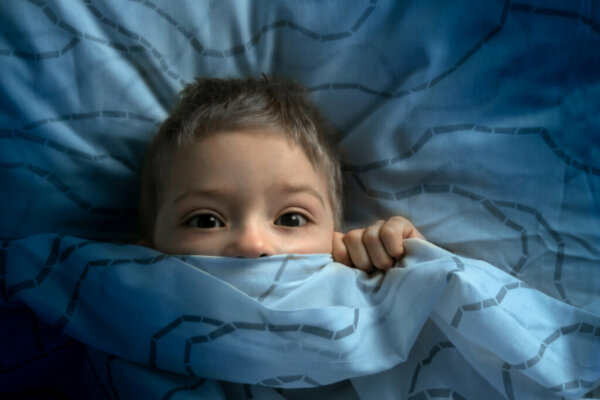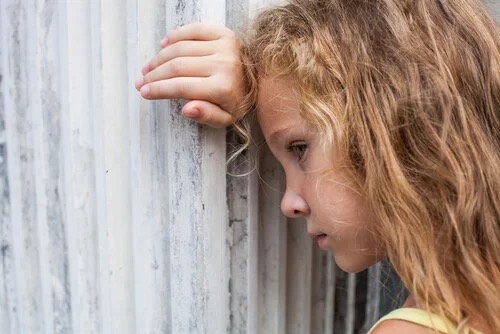Generalized anxiety disorder in children is one of the most prevalent clinical childhood disorders. Indeed, the appearance of fears and worries in little ones is quite common. However, some of them suffer extreme and disabling symptoms. Naturally, this affects their quality of life.
As a matter of fact, a large percentage of children around the ages of four to five experience this disorder. Parents usually don’t pay too much attention to it at first. They tend to assume that the symptoms are just due to growing up and they’ll disappear over time.
Nevertheless, anxiety that isn’t dealt with in childhood will follow the child into adolescence and adulthood. Then, sooner or later, depressive symptoms will appear. In fact, this disorder will affect their social life, their academic performance, and their personality formation.
Generalized anxiety disorder usually begins in early childhood. Early detection can prevent children from reaching adulthood with this particular mental health problem that’s extremely prevalent in the adult population.
The incidence of generalized anxiety disorder in children
We know that between 15 and 20 percent of the child and young population (three –18 years) suffers from anxiety. The figure is highest in adolescence. With regards to generalized anxiety disorder, the prevalence is 3 percent.
Tulane University in New Orleans conducted research that suggested extremely young children suffer from this disorder. In fact, by the age of five, they often exhibit certain anxious behaviors. However, it isn’t until they go to school that they receive a diagnosis of generalized anxiety disorder.
It’s imperative that a correct diagnosis is given. Because, in many cases, they could be suffering from separation anxiety or phobias. These are clinical realities that can disappear over time. However, generalized anxiety disorder tends to be a chronic condition.
Symptoms of generalized anxiety disorder
Generalized anxiety disorder presents different symptoms in children from those experienced by adults. For this reason, we should be aware of any symptoms which could be confused with any other disorders.
The first aspect we must take into account is that children tend to somatize their symptoms. This means that they convert their psychic issues into organic symptoms. Generalized anxiety disorder usually presents itself with the following symptoms:
- Heightened concern over insignificant matters.
- Repeated questions about negative events that could happen in the future.
- Persistent insecurities and fear regarding things that could happen to them or their parents.
- Refusal to carry out usual activities. For example, playing outside, going to school, going swimming, going hiking, going for sleepovers, etc. This is due to anxiety, insecurity, and fear about what may happen to them.
- Problems with concentration.
- Digestive discomfort. For instance, stomach pain or nausea.
- Intestinal disorders such as diarrhea.
- Sleep disturbances.
- Headaches and dizziness.
- Persistent need to go to the bathroom to urinate.
- Feeling like they have a lump in their throat that stops them from swallowing.
- Extreme tiredness.
- Generally, they’re children who seek the closeness and protection of adults.
- They’re usually irritable. Furthermore, they get angry extremely easily and have little patience.
How is it diagnosed?
The presence of generalized anxiety disorder in children may be diagnosed in accordance with the Diagnostic and Statistical Manual of Mental Disorders (DSM-5). Nevertheless, the health professional should also evaluate a number of aspects concerning the child’s life. These are:
- Date of onset and how the symptoms have developed.
- The anxiety itself. For example, is it generalized or does it occur in response to certain stimuli?
- The impact of symptoms on the child’s daily life.
- The presence of any biopsychosocial stressors. In other words, is there anything going on in the child’s life to make them react in this way?
- Possible comorbidity of other clinical disorders. These could be depression, ADHD, phobias, etc.
- The child’s evolutionary history.
- Family history.
- School reports.
- Medical reports.
- Observation of the child’s behavior. The therapist should interview the child and carry out any relevant diagnostic tests.
Causes of generalized anxiety disorder in children
At present, the medical profession doesn’t know for certain what causes generalized anxiety disorder in children. However, they think that there may be multiple causes involving both genetic and environmental factors.
Genetic factors
The clinical psychology unit of the University of Leiden (Netherlands) discovered some remarkable evidence. They found that generalized anxiety disorder in children is inherited. In fact, genetics accounts for 30 percent of the cases.
Furthermore, in the home, children tend to model themselves on their parents’ patterns of behavior. In other words, they internalize the behaviors and reactions of their parents. This means that excessive worrying, overreacting, and fear can be transmitted from parent to child.
Early trauma
Psychological trauma is one of the most common causes of generalized anxiety disorder. For example, abuse or parental abandonment leaves a deep emotional wound that often manifests itself as anxiety.
Children who suffer from generalized anxiety disorder can often be extremely quiet and shy. They may also frequently have tantrums. Parents must be sensitive to these eventualities. In this way, they’re able to understand any underlying issues.

Therapy and treatment for children
Once a child receives a diagnosis of generalized anxiety disorder, the way of treating it is multidisciplinary. In fact, therapists may use several approaches to improve the quality of life of the child.
Psychological therapy
Cognitive-behavioral therapy is the most effective treatment for childhood anxiety. The approach to be taken always depends on the age of the child or adolescent. However, in most cases, the process of psychotherapy can help the child:
- Develop a positive internal dialogue.
- Manage their fears and develop healthier thoughts.
- Understand and manage their emotions.
- Develop relaxation techniques.
- Improve their coping skills in the face of discomfort and worry.
- Develop better social skills and self-esteem.
However, it’s important that parents are also involved in the therapy. Because they can help the child understand their situation.
Pharmacological approach
Sometimes, childhood anxiety also requires pharmacological treatment. In these cases, doctors usually prescribe selective serotonin reuptake inhibitors (SSRIs). Indeed, these are the most effective treatment with the fewest side effects.
Being more sensitive to children’s needs
Anxiety disorders are increasing in children. Furthermore, in addition to generalized anxiety disorder, they’re suffering from other conditions such as panic disorders and separation anxiety. While it’s true that there could be biological factors to explain the appearance of these disorders, the most obvious causes are psychosocial. In fact, environmental events and changes, as well as family dynamics, tend to determine the conditions in many instances.
Early detection, the support of medical professionals, and the closeness of parents at all times will undoubtedly guarantee good therapeutic progress. Finally, it’s clear that parents and educators must be more sensitive overall to children’s needs.
Childhood Anxiety Disorders and Treatments
https://lamenteesmaravillosa.com/trastorno-ansiedad-generalizada-ninos/
The post Generalized Anxiety Disorder in Children appeared first on Exploring your mind.



















Comments